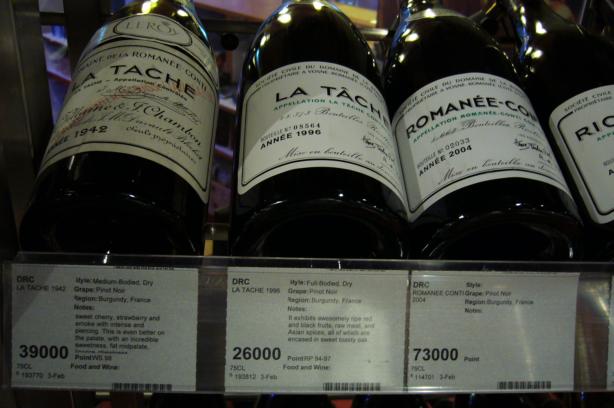Watson’s Wine Cellar around the corner from the Yung Kee restaurant in Hong Kong Central is an oenophile’s wet dream: serried rows of Bordeaux first growths, Pétrus (HK$42 000 for the ’69) and DRC delights (La Tâche ’42 a snip at HK$ 39 000, Romanée-Conti ’04 HK$ 73 000 = R96 000) by the shelf-full. Vinous pornography at it’s most hard core perhaps, but we’re all consenting adults, so what harm is done?
As importer Michael Fridjhon remarked, these prices are remarkable and the selection (including a Catholic array of second labels), ditto. With corkage charged at HK$100 a bottle, Yung Kee patrons are well advised to BYO. Although restaurant mark-ups seem modest (around 25% above retail, in stark contrast to rip-off levels in SA) increased selection is the main reason to BYO.

But you’ll search in vain for a bottle of mainland Chinese wine in Watson’s even if the group is owned by Hutchinson Whampoa, a former Hong turned global multinational operation in 56 countries, with 230 000 employees and turnover in the hundreds of billions of HK$. As James Hepple, operations and marketing for controller for Watson’s admits “there is no Chinese wine here as there is no call for it. It’s the same with cars – people want BMW, not Chinese brands.” Confirming that cultural cringe is not restricted to SA.

We’re standing in the most recently opened of Watson’s 14 stores (with another in Macau and one on the mainland). James continues “the Hong Kong wine market is really only 10 years old. Chinese people are health obsessed and when those newspaper reports on the health benefits of red wine appeared in 1998, interest in wine really took off.” Still Hong Kong has the lowest per capita wine consumption of any city in the developed world, at around 2 litres per adult per annum.
James calls his stock of French icons “face wine. Chinese people buy wine for face, to show that they have arrived and how much they can afford and if it’s a present, how much they appreciate you.” Hence the subterranean Aladdin’s Cave of first growths and claret accounting for 25% of turnover. As expected and in defiance of a tropical climate, red outsells white by 2:1 as red is a most auspicious colour in Chinese society as I reminded Michael as he purchased a dapper silk bowtie after lunch at the Foreign Correspondents’ Club.
Across the road at the groaning multi-level Yung Kee temple of tourist food, wine is conspicuous by its absence from the dining table, with patrons more likely to be drinking green tea. “Chinese people don’t associate food and wine in the same way as Europeans do. Not to say that food and wine pairing isn’t starting to take off. But wine is more likely to be drunk on special occasions or at home.” With the 200 outlets of Watson’s ParknShop supermarket chain likely suppliers like the one at the Peak Tram terminus.
Watson’s specialist wine division are agency importers of several SA brands. The selection of whites is heavily skewed in favour of Sauvignon Blanc (Thelema, Vergelegen and Reyneke) with one Sémillon (Boekenhoutskloof) and a Thelema Chardonnay. The selection of reds is better with some fairly keen prices:
• Diemersfontein Pinotage 07 HK$165
• Boekenhoutskloof Syrah 06 HK$318
• Chocolate Block 07 HK$238
• De Toren Fusion V 05 HK$245 (on special)
• Thelema Merlot Reserve 05 HK$498
• Thelema Mint Cabernet 05 HK$438
Three reds from Camberley confirm that Johnnie Nel has been busy while Johan Reyneke’s Cornerstone 2006 is listed as “organic” when James could have done a Full Monty and claimed “biodynamic.”




